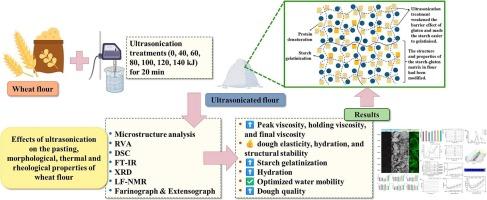Ultrasonication-induced structural and functional modification of starch in wheat flour
IF 9.7
1区 化学
Q1 ACOUSTICS
引用次数: 0
Abstract
This study investigated the effects of ultrasonication on the pasting, morphological, thermal, and rheological properties of wheat flour and dough, highlighting its potential as a green and sustainable processing technology. Wheat flour was treated with ultrasonic energy levels ranging from 40 to 140 kJ for 20 min. Rapid visco analysis (RVA) showed that at 40 kJ, peak viscosity increased from 1045.67 mPa·s (control) to 1259.00 mPa·s, and final viscosity rose from 2011.33 mPa·s to 2146.67 mPa·s, indicating enhanced gelatinisation. Differential scanning calorimetry revealed an increase in gelatinisation enthalpy (ΔH) from 8.03 J/g to 9.53 J/g, suggesting enhancement in molecular organisation. Rheological measurements demonstrated that ultrasonicated samples at 40 kJ and 100 kJ exhibited the lowest tan δ, suggesting improved elasticity and structural integrity. FTIR analysis confirmed intensified hydrogen bonding and improved gluten network formation. Low-field NMR and MRI analyses showed that ultrasonication significantly influenced water mobility and distribution within the dough. Moderate energy treatments (40 kJ to 100 kJ) enhanced water retention and network development. Scanning electron microscopy revealed surface roughness and partial granule disruption. These findings confirm that moderate ultrasonication enhances flour functionality by improving hydration, viscoelasticity, and thermal behaviour without the use of chemical additives. Ultrasonication offers an eco-friendly and energy-efficient approach for modifying wheat flour to improve the quality of sustainable flour-based products.

超声诱导小麦粉中淀粉的结构和功能改性
本研究研究了超声波对小麦粉和面团的糊化、形态、热、流变特性的影响,强调了其作为一种绿色和可持续加工技术的潜力。用40 ~ 140 kJ的超声波处理小麦粉20 min。快速粘度分析(RVA)表明,在40 kJ时,峰值粘度从1045.67 mPa·s(对照)增加到1259.00 mPa·s,最终粘度从2011.33 mPa·s增加到2146.67 mPa·s,表明糊化作用增强。差示扫描量热法显示凝胶化焓(ΔH)从8.03 J/g增加到9.53 J/g,表明分子组织增强。流变学测量表明,40 kJ和100 kJ超声处理的样品具有最低的tan δ,表明弹性和结构完整性得到改善。FTIR分析证实氢键增强,面筋网络形成改善。低场核磁共振和核磁共振分析表明,超声波对面团内水分的流动和分布有显著影响。适度的能量处理(40 ~ 100 kJ)提高了水潴留和网络发育。扫描电镜显示表面粗糙和部分颗粒断裂。这些发现证实,在不使用化学添加剂的情况下,适度的超声波可以通过改善水化、粘弹性和热行为来增强面粉的功能。超声波为改善面粉的质量提供了一种环保和节能的方法。
本文章由计算机程序翻译,如有差异,请以英文原文为准。
求助全文
约1分钟内获得全文
求助全文
来源期刊

Ultrasonics Sonochemistry
化学-化学综合
CiteScore
15.80
自引率
11.90%
发文量
361
审稿时长
59 days
期刊介绍:
Ultrasonics Sonochemistry stands as a premier international journal dedicated to the publication of high-quality research articles primarily focusing on chemical reactions and reactors induced by ultrasonic waves, known as sonochemistry. Beyond chemical reactions, the journal also welcomes contributions related to cavitation-induced events and processing, including sonoluminescence, and the transformation of materials on chemical, physical, and biological levels.
Since its inception in 1994, Ultrasonics Sonochemistry has consistently maintained a top ranking in the "Acoustics" category, reflecting its esteemed reputation in the field. The journal publishes exceptional papers covering various areas of ultrasonics and sonochemistry. Its contributions are highly regarded by both academia and industry stakeholders, demonstrating its relevance and impact in advancing research and innovation.
 求助内容:
求助内容: 应助结果提醒方式:
应助结果提醒方式:


